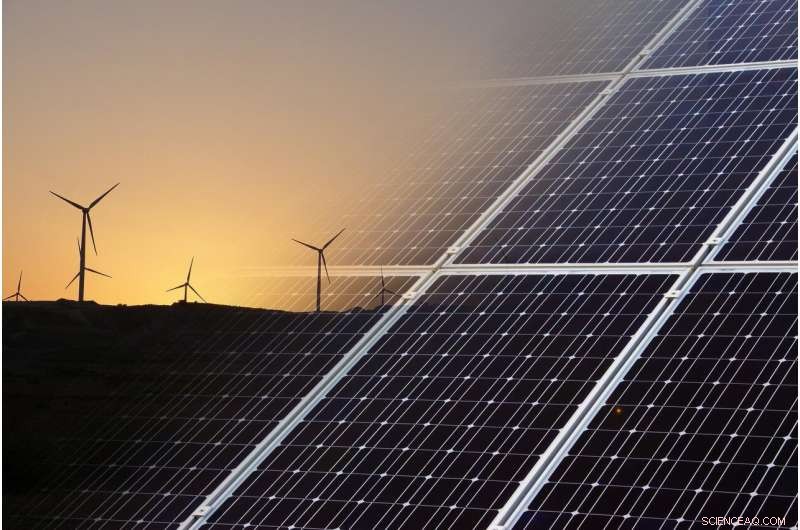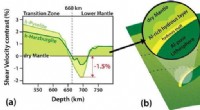Hvad er dekarbonisering, og hvordan får vi det til at ske?

Kredit:Pixabay/CC0 Public Domain
For at forhindre, at planeten opvarmes mere end 1,5°C over førindustrielt niveau, har de fleste lande, inklusive USA, mål om at nå netto nul i 2050. Netto nul betyder, at alle producerede drivhusgasemissioner modsvares af en lige stor mængde emissioner der er elimineret. At opnå dette vil kræve hurtig dekarbonisering.
Der er to aspekter ved dekarbonisering. Den første indebærer en reduktion af drivhusgasemissionerne fra forbrænding af fossile brændstoffer. Dette kan gøres ved at forhindre emissioner gennem brug af kulstoffri vedvarende energikilder såsom vind, sol, vandkraft, geotermisk energi og biomasse, som nu udgør en tredjedel af den globale elkapacitet, og elektrificere så mange sektorer som muligt. Energieffektivitet vil reducere efterspørgslen efter energi, men stigende elektrificering vil øge den, og i 2050 forventes efterspørgslen efter strøm at være mere end det dobbelte af, hvad det er i dag.
Følgelig vil dekarbonisering også kræve, at kulstof fra atmosfæren absorberes ved at opfange emissioner og forbedre kulstoflagring i landbrugsarealer og skove.
For at opnå dekarbonisering skal alle aspekter af økonomien ændre sig - fra hvordan energi genereres, og hvordan vi producerer og leverer varer og tjenester, til hvordan jorder forvaltes. De kuldioxid- og methanemissioner, der opvarmer planeten, kommer i vid udstrækning fra energiproduktion, industri, transport, bygninger og landbrug og arealanvendelse i den globale økonomi, så disse sektorer skal alle transformeres. Her er, hvordan dekarbonisering kunne se ud i hver sektor.
Strømproduktion
Med den globale befolkning, der forventes at nå op på 10 milliarder i 2060, og stigende elektrificering af samfundet, vil efterspørgslen efter elektricitet vokse, så det er vigtigt at reducere emissionerne pr. produceret elektricitetsenhed. Elproduktion, herunder el- og varmeproduktion, er ansvarlig for 30 % af den globale CO2 emissioner på grund af de involverede fossile brændstoffer; de skal erstattes af vedvarende energi.
Vedvarende kilder er nu så økonomiske, at de udgjorde størstedelen af den nye energiproduktionskapacitet i 2018. Solenergipriserne er faldet omkring 80 % i de sidste 10 år, mens vindkraft er faldet 40 %. Omkostningerne til batterilagring i forsyningsskala faldt med 70 % mellem 2015 og 2018. Men fordi vedvarende energikilder er intermitterende, er forsyningsselskaber stadig afhængige af den konsekvente basisenergi, som fossile brændstoffer og atomkraftværker kan levere.
For at USA kan nå sit netto-nulmål, skal det gå fra at producere omkring 20 % af elektriciteten fra kulstoffrie kilder i dag til mindst 75 % i 2030. Dette vil kræve øget vedvarende energiproduktion og opretholdelse af nukleare energikilder, hvis atomkraften planter er sikre. Kulværker skal pensioneres eller eftermonteres for at opfange 90 % af deres emissioner. Kulstoffangst, -udnyttelse og -lagring skal udvides for at opfange CO2 emissioner fra resterende fossile brændselskraftværker. Denne CO2 kan bruges på stedet eller transporteres andre steder til brug i brændstoffer, kemikalier eller byggematerialer eller sprøjtes ind i et underjordisk reservoir til permanent opbevaring.
Kraftværker skal også gøres mere energieffektive. To tredjedele af den energi, der forbruges til at producere elektricitet, går tabt som spildvarme; using that waste heat to warm the plant or nearby buildings, for example, can increase the energy efficiency of power generation by 80%.
Transmission lines must be built out to take renewable energy from where it is generated to all parts of the country. As renewables are increasingly integrated into the grid, improved low-cost energy storage for the grid is needed to help smooth out their intermittency and ensure dependability, especially as climate change brings more extreme weather. Distributed generation—small, decentralized modular energy generation systems such as microgrids —can use renewable energy and add resilience to the existing grid.
Incentive programs are also important to encourage consumers to reduce energy use at times of high stress on the grid and to manage home energy consumption via apps.
How Columbia is contributing
- Columbia's Sabin Center for Climate Change Law provides pro bono legal support for people who want to see renewable energy development in their communities but are facing opposition.
- In nature, CO2 spontaneously reacts with certain rocks, trapping the planet-warming gas in a solid mineral form. Peter Kelemen of Columbia's Lamont-Doherty Earth Observatory is finding ways to utilize this process at a large scale for decarbonization. Two start-up companies are already putting his innovations to work.
- David Goldberg, a research professor at Columbia University's Lamont-Doherty Earth Observatory, has suggested pairing offshore wind turbines with technology that captures carbon dioxide. That way, when the turbines generate more electricity than is needed to meet consumer demand, the extra electricity could be used to pull CO2 from the air.
- Powerful batteries are needed to store renewable energy for times when the sun isn't shining and the wind isn't blowing. Dan Steingart from Columbia Engineering is working to build better batteries. In one ongoing project, he aims to greatly simplify and lower the cost of manufacturing lithium-ion batteries by changing their internal structure.
Industry
Industrial processes—such as steel, cement, and chemical production as well as oil, coal and gas extraction and refining—produce 30% of global CO2 emissions and 33% of methane emissions. Industry consumes 32% of U.S. energy.
This sector is one of the hardest to decarbonize because steel, cement, and chemical production may require temperatures of 1600°C or more, which are easily produced by fossil fuel combustion, but difficult to achieve through electrification. To electrify this intense heat generation would require significant changes to furnaces and so much energy that it would likely be economically unfeasible.
To truly decarbonize industry, production processes will need to be redesigned. Energy efficiency in industry can be increased through integrating processes, whether through initial design, retrofitting, or making operations more energy efficient. Cogeneration, where wasted heat is used to produce additional heat or electricity for the plant itself, and clustering plants at one site, which allows for synergy of operations or resources, are examples of process integration.
Processes should be electrified with renewable energy where possible. Sustainably produced biomass can be used for fuel at some cement factories and new steel plants, and for ethylene and ammonia production. Steel can be also produced through charcoal combustion rather than coal; charcoal is considered a renewable energy source since it comes from wood which grows relatively quickly. And ammonia, which is used for fertilizer, could be made with green hydrogen.
The use of carbon capture should be expanded as it is the only technology that can significantly curtail emissions from cement production.
How Columbia is contributing
- When it comes to decarbonizing steel production, the Columbia's Center on Global Energy Policy has identified carbon-neutral biomass and carbon capture and storage as two of the lowest cost and most technologically mature solutions.
- At an Iceland-based pilot project called CarbFix—designed and carried out with Columbia leadership—researchers are reacting basaltic rock with CO2 captured from a power plant. The team mixes gasses generated by a geothermal power plant with water and reinjects the solution into the volcanic basalt below. There, the carbon precipitates out into whitish, chalky minerals—carbonates. CarbFix currently injects and stores about 10,000 tons of CO2 per year in solid carbonate minerals below ground.
- While hydrogen fuel can be created from natural gas, Dan Esposito, associate professor of chemical engineering at Columbia University, is testing technologies that use solar energy to make carbon-free "green" hydrogen.
Transport
Transportation and transport, including aviation and maritime, generate 19% of CO2 emissioner. To reach net zero in the U.S., 50% of all new vehicles must be zero-emission by 2030. This means they need to be electric vehicles (EVs) powered by renewable energy, or hydrogen fuel cell vehicles. More EVs on the road will necessitate expanding the EV charging station infrastructure across the country as well as developing better and cheaper batteries. Enhanced vehicle performance and fuel efficiency are also important for decreasing emissions.
Mass transit options and the railroad network need to be expanded, as well as car sharing services. For long-haul trucking, which is difficult to electrify, low-carbon fuels such as hydrogen and synthetic liquid fuels can be used. Aviation, which is responsible for 2.1% of global CO2 emissions, is considered the most difficult sector to decarbonize. Aviation's emissions can be reduced through improved air traffic management, such as using more direct routes, and flying at optimal speeds and altitudes, and eventually through the adoption of alternative fuels such as biofuels and green hydrogen. Maritime transport runs on heavy fuel oil, producing 2.5% of global emissions. New vessels could reduce emissions through technical improvements, such as waste heat recovery and streamlined operations. Because the heavy fuel oil is much cheaper than alternative fuels, however, it's unlikely that maritime transport will switch to low-carbon fuels in the near future.
How Columbia is contributing
- The Climate School's Center for Sustainable Urban Development created an app to help people in Nairobi access an informal network of minibuses, an important form of public transit in that city. Recently, they also co-authored a report on how minibuses could be made electric in three African cities.
Buildings
Buildings are responsible for 6% of CO2 emissioner. Some of these emissions are embodied in the buildings from the mining, processing, manufacture, transportation, and installation of materials they are made of. Other emissions are generated by buildings through the operation of their heat, electric, and cooling systems, cooking, and appliances.
For new building construction, more efficient manufacturing of building materials, and the use of greener materials such as wood from sustainably managed forests, non-toxic recycled materials, or concrete that incorporates CO2 will reduce emissions. Carbon-negative buildings can produce more energy than they themselves need with solar panels and feed it back to the grid.
Existing and older buildings need to be retrofitted to increase energy efficiency through improving insulation, sealing gaps, switching to electrified heating and cooling systems with heat pumps running on renewable energy, installing LEDs, implementing smart energy management systems, and creating incentives for energy efficient appliances and electric cookstoves. National efficiency standards for buildings, heating and cooling equipment, and appliances are needed to drive these changes.
How Columbia is contributing
- Mechanical engineer Vijay Modi has investigated how to decarbonize heating systems, which often run on oil or natural gas. His lab has found that using electric heat pumps powered by renewable energy could dramatically reduce greenhouse gas emissions, and save consumers money.
- Cement manufacturing is responsible for 5% of global CO2 emissioner. Alissa Park, director of the Lenfest Center for Sustainable Energy, is working on a "greener" cement made with captured carbon emissions. Her method reacts ash from power plants with captured CO2 to produce calcium carbonate. This material can be used to make concrete or paper with a lower carbon footprint. Park is using a similar process to clean up waste from the production of steel, another essential construction material.
- Dan Esposito and Shih Kawashima from Columbia Engineering are working to decarbonize the cement-making process as well. Their process extracts raw materials from seawater and uses room-temperature processing to convert them into cement that is comparable in strength to Portland cement, today's industrial standard. They estimate their cement could absorb more than 100 kilograms of CO2 per ton of concrete—rather than releasing 170 kilograms per ton through the usual process.
Agriculture and land use
Agricultural energy use and practices generate 1% of CO2 emissions and 38% of methane emissions, the latter mainly from livestock production. Carbon emissions can be reduced through more sustainable farming practices, such as regenerative agriculture that enhances soil carbon storage and protects biodiversity. Stronger incentives are needed to encourage farmers to adopt these sustainable techniques, as well as to reduce the methane cattle produce as they digest by using additives in their food.
Consumers can help by reducing their meat and dairy intake, because forests are being destroyed to grow soy for animal feed and to create pasture land for livestock grazing. These changes in land cover are responsible for 14% of CO2 emissions and 5% of methane emissions. As the world's forests are deforested and disturbed, they emit almost 9 billion tons of carbon dioxide into the atmosphere each year. Recent research found that the amount of carbon emitted due to the deforestation of tropical forests has doubled since 2001.
Incentives are needed to encourage afforestation, the planting of new forests, and the reforestation of degraded forests to increase carbon sequestration, and to support keeping remaining forests protected and intact.
How Columbia is contributing
- An analysis from the Center on Global Energy Policy found that the conversion of natural ecosystems to agricultural croplands or pastures is the largest source of greenhouse emissions in the entire food system, contributing nearly 3 billion metric tons per year.
Some countries are on their way
Some countries are making good progress towards decarbonization. China, Costa Rica, Denmark, Ethiopia, and the United Kingdom are further along to net zero than many others, mainly because of the natural resources they are blessed with. Ethiopia and Costa Rica get the majority of their electricity from hydropower; Norway generates 97% and Paraguay 99% of their electricity from renewable energy, mostly hydropower. China,
Denmark and the U.K. have targets for energy efficiency along with the policies and investments to support them. The U.S. and China installed the most wind and solar PV in 2019, and almost 25% of China's energy is electricity rather than natural gas or oil. Germany recently announced plans to get all of its electricity from renewable sources by 2035.
Challenges and limitations
According to the Brookings Institution, achieving net zero by 2050 is technically and economically feasible with current technologies and those in development, but it will require enormous behavioral changes, rigorous new policies, and international cooperation.
One thing that makes decarbonization challenging is that while it will be profitable over the long-term, it will require huge investments in the short term. It will likely take $275 trillion between 2021 and 2050 to decarbonize the sectors above, with power generation, transportation, and buildings using 75% of the spending on physical assets.
Research has predicted that to completely decarbonize industry would take four to nine times as much zero carbon electricity as it would if we do nothing to decarbonize, so the cost of electricity is expected to rise as renewable resources are expanded and the grid infrastructure is built out. Eventually the price of electricity from renewable sources will likely drop because of lower operating costs, but consumers may initially face higher energy costs.
The single biggest challenge to decarbonization is how much money has been invested in the grid and fossil fuel infrastructure, said Steve Cohen, a professor in the practice of public affairs at Columbia University's School of International and Public Affairs, and director of the Research Program on Sustainability Policy and Management. "The average person has also invested a lot in fossil fuels through their boilers and gasoline powered cars. So the challenge will only be overcome when renewable energy gets so cheap and convenient that it will drive fossil fuels from the market."
Renewable energy also threatens the business model of the grid where people pay utilities for their power, and fossil fuel interests are pushing back, Cohen added. For example, the California Public Utilities Commission is considering a "grid integration" tax on people who feed extra energy from their solar arrays back to the grid.
Reaching 100% decarbonization also depends on new technologies that are still costly and not yet at scale. Biofuels are expensive and supplies are limited since they could compete with food for land. Carbon capture, utilization, and storage is effective but will require technological improvements and scaling up to reduce its cost. Bioenergy carbon capture and storage, where biomass such as wood pellets or agricultural waste is burned for fuel and the emissions are captured and stored, is a relatively new technology, and has not yet been scaled up. Green hydrogen, produced through the electrolysis of water using renewable energy, costs three times as much as natural gas in the U.S.
"The government needs to make massive investments in science and into these new technologies to accelerate the decarbonization process," said Cohen. Private investors are eager to invest in green technology, but the lack of consistent and long-term policies to ensure continuing carbon reduction efforts makes investing risky.
That is why a wide range of policies that set performance standards and goals and provide incentives to reward CO2 reduction are needed to drive investment into low-carbon technologies. A global carbon tax would also help push economies to decarbonize though it would further raise the cost of energy. The policies that are needed to spur progress towards decarbonization are difficult to enact, however, because of political polarization and lobbying efforts by the fossil fuel industry.
For example, 20 states with Republican controlled legislatures have adopted preemption laws backed by fossil fuel interests that prohibit the states from banning natural gas, which means preventing them from moving to the electrification of buildings. Texas passed a law requiring state pension funds to divest from companies moving away from fossil fuels, and a West Virginia law would prevent companies that boycott energy firms from receiving state contracts.
The latest report by the IPCC found that climate change is occurring so rapidly that humans may not be able to adapt to its impacts. What is needed to help stymie the attempts to further impede climate action is a citizenry that is better educated about climate impacts, the critical need to decarbonize, and what it will require. Moreover, it's important that there are measures in place, such as subsidies to offset higher energy prices, to ease any resulting economic burdens, particularly for disadvantaged and low-income communities.
Cohen is confident that we will be able to decarbonize our economy in time to avoid catastrophic climate impacts. However, rather than framing the issue in terms of climate change, he believes it would be more effective to highlight something everyone can agree on. "We should focus on a consensus that we can build on:modernizing our vulnerable and antiquated energy grid. A modern, lower cost energy system that is less polluting is something everyone should find appealing because we all rely on energy."
 Varme artikler
Varme artikler
-
 Oversvømmelser påvirker mere end 1 million over hele ØstafrikaOversvømmelser ses fra luften i Greater Pibor Administrative Area i Sydsudan, Fredag, 4. sept., 2020. Oversvømmelser har ramt langt over en million mennesker i hele Østafrika, endnu en katastrofe, der
Oversvømmelser påvirker mere end 1 million over hele ØstafrikaOversvømmelser ses fra luften i Greater Pibor Administrative Area i Sydsudan, Fredag, 4. sept., 2020. Oversvømmelser har ramt langt over en million mennesker i hele Østafrika, endnu en katastrofe, der -
 Transport af vand ind i den dybe Jord af Al-fase D(a) Forskydningshastighedskontrast mellem det Al-rige vandholdige lag (inklusive Al-fase D) og den tørre kappe for to modelsammensætninger:vandholdig pyrolit (h-pyrolit) og vandholdig harzburgit (h-Ha
Transport af vand ind i den dybe Jord af Al-fase D(a) Forskydningshastighedskontrast mellem det Al-rige vandholdige lag (inklusive Al-fase D) og den tørre kappe for to modelsammensætninger:vandholdig pyrolit (h-pyrolit) og vandholdig harzburgit (h-Ha -
 Ultrahøjtrykslasereksperimenter kaster lys over superjordkernerInde i målkammeret på University of Rochesters Omega Facility, et team af forskere, herunder Princeton Universitys Thomas Duffy og June Wicks, bruger lasere til at komprimere jern-siliciumprøver til d
Ultrahøjtrykslasereksperimenter kaster lys over superjordkernerInde i målkammeret på University of Rochesters Omega Facility, et team af forskere, herunder Princeton Universitys Thomas Duffy og June Wicks, bruger lasere til at komprimere jern-siliciumprøver til d -
 Infrarødt NASA -billede giver Paulettes temperaturpaletDen 9. september kl. 12:47. EDT (0447 UTC) NASAs Aqua -satellit analyserede Tropical Storm Paulette ved hjælp af det atmosfæriske infrarøde lyd- eller AIRS -instrument. AIRS fandt de koldeste skyhøjes
Infrarødt NASA -billede giver Paulettes temperaturpaletDen 9. september kl. 12:47. EDT (0447 UTC) NASAs Aqua -satellit analyserede Tropical Storm Paulette ved hjælp af det atmosfæriske infrarøde lyd- eller AIRS -instrument. AIRS fandt de koldeste skyhøjes
- Bevægelsesfremmende eksoskeletter kan hæmme beslutningstagningen
- Google tjener skyhøje smartphonepriser med den nye Pixel
- Hvad er en markørmolekyle?
- Gaia begynder at kortlægge den galaktiske bar i Mælkevejen
- En model til at forudsige størrelsen og formen på online kommentartråde
- Hvordan man opbygger en slaggrænse


